Word Order in Complex Verb Phrases in Heritage Polish Spoken in Germany
Abstract
1. Introduction
2. Theoretical Background
2.1. Word Order in Heritage Varieties of Polish and Other Languages
2.2. Age Effects in Heritage Language Acquisition
2.3. Studied Structure
| 1. | On | chc-e | złapać | ptak-a |
| He-NOM | want-PRST.3SG | catch-INF.PF | bird-ACC.SG | |
| “He wants to catch a/the bird.” | ||||
| 2. | On | chc-e | go | złapać |
| He-NOM | want-PRST.3SG | he-ACC.clitic | catch-INF.PF | |
| “He wants to catch him/it.” | ||||
| 1’. | On | chc-e | ptak-a | złapać |
| He-NOM | want-PRST.3SG | bird-ACC.SG | catch-INF.PF ACC.SG | |
| “He wants to catch a/the bird.” | ||||
| 2’. | On | chc-e | złapać | go | za | ogon |
| He-NOM | want-PRST.3SG | catch-INF.PF | he-ACC.clitic catch-INF.PF | by | tail-ACC | |
| “He wants to grab him/it by the tail.” | ||||||
| 3. | a. | Er | will | den | Vogel | fangen |
| He-NOM | want-PRST.3SG | DET-ACC.M | bird | catch-INF | ||
| “He wants to catch the bird.” | ||||||
| b. | Er | will | ihn Vogel | fangen | ||
| He-NOM | want-PRST.3SG | he-ACC bird | catch-INF | |||
| “He wants to catch him/it.” | ||||||
2.4. Research Questions and Hypotheses
3. Study Design
3.1. Participants
3.2. Methods
| 4. | Musz-ę | dw-a | raz-y | w | tygodni-u | prani-e | zrobić |
| must-PRST.1SG | two-M. | time-ACC.PL | in | week-LOC. | laundry-ACC | do-INF.PF | |
| “I have to do the laundry twice a week.” | |||||||
| 5. | Mam-a | zabroni-ł-a | mu | w | mieszkani-u | grać | w | piłk-ę |
| mum-NOM | prohibit-PAST-F | he-DAT. clitic | in | apartment-LOC | play-INF.IPF | in | ball-ACC | |
| “Mum prohibited him to play ball in the apartment.” | ||||||||
4. Results
4.1. Oral Production Data
4.1.1. Simultaneous Bilinguals vs. Monolinguals
4.1.2. Early Sequential Bilinguals vs. Monolinguals
4.2. Judgment Data
5. Discussion
5.1. Oral Production Data
5.1.1. Age Effects I: Simultaneous Bilinguals vs. Monolinguals (RQ1)
5.1.2. Age Effects II: Early Sequential Bilinguals vs. Monolinguals (RQ2)
5.1.3. Age of Onset Effects: Simultaneous Bilinguals vs. Early Sequential Bilinguals (RQ3)
5.2. Judgment Data (RQ4)
5.3. Language-Internal Factors: Clause Structure (RQ5)
6. Conclusions
Author Contributions
Funding
Institutional Review Board Statement
Informed Consent Statement
Data Availability Statement
Conflicts of Interest
Appendix A
| Verb Phrases | Verb Phrases with NP | Verb Phrases with Pronoun | |||||
|---|---|---|---|---|---|---|---|
| Group | Age Span (years; months) | Discontinuous | Adjacent | Discontinuous | Adjacent | Discontinuous | Adjacent |
| 2L1 | 3;0–6;11 | 20 | 12 | 13 | 10 | 6 | 0 |
| 63% | 38% | 57% | 43% | 100% | 0% | ||
| 2L1 | 7;0–9;11 | 31 | 20 | 10 | 17 | 20 | 3 |
| 61% | 39% | 37% | 63% | 87% | 13% | ||
| 2L1 | 10;0–13;11 | 11 | 32 | 6 | 28 | 3 | 4 |
| 25% | 75% | 18% | 82% | 43% | 57% | ||
| 2L1 | 15–17 | 4 | 17 | 1 | 13 | 1 | 2 |
| 19% | 81% | 7% | 93% | 33% | 67% | ||
| 2L1 | 17–25 | 65 | 39 | 23 | 25 | 21 | 4 |
| 63% | 38% | 48% | 52% | 84% | 16% | ||
| cL2 | 3;0–6;11 | 3 | 9 | 0 | 8 | 3 | 1 |
| 25% | 75% | 0% | 100% | 75% | 25% | ||
| cL2 | 7;0–9;11 | 20 | 16 | 11 | 14 | 9 | 2 |
| 56% | 44% | 44% | 56% | 82% | 18% | ||
| cL2 | 10;0–13;11 | 20 | 21 | 8 | 20 | 12 | 1 |
| 49% | 51% | 29% | 71% | 92% | 8% | ||
| cL2 | 15–18 | 18 | 16 | 6 | 11 | 8 | 1 |
| 53% | 47% | 35% | 65% | 89% | 11% | ||
| cL2 | 20–36 | 21 | 18 | 13 | 10 | 4 | 4 |
| 54% | 46% | 57% | 44% | 50% | 50% | ||
| L1 | 3;7–11;11 | 24 | 56 | 2 | 48 | 20 | 4 |
| 30% | 70% | 4% | 96% | 83% | 17% | ||
| L1 | 19–38 | 57 | 98 | 8 | 65 | 34 | 10 |
| 37% | 63% | 11% | 89% | 77% | 23% | ||
Appendix B
| Discontinuous Verb Phrases | |||||
|---|---|---|---|---|---|
| with NP | with Pronoun | ||||
| Group | Age Span (years; months) | Accepted | Rejected | Accepted | Rejected |
| 2L1 | 3;0–6;11 | 8 | 0 | 8 | 0 |
| 100% | 0% | 100% | 0% | ||
| 2L1 | 7;0–9;11 | 10 | 4 | 13 | 2 |
| 71% | 29% | 87% | 13% | ||
| 2L1 | 10;0–13;11 | 4 | 5 | 8 | 1 |
| 44% | 56% | 89% | 11% | ||
| 2L1 | 17–25 | 78 | 17 | 19 | 0 |
| 82% | 18% | 100% | 0% | ||
| cL2 | 3;0–6;11 | 4 | 0 | 3 | 1 |
| 100% | 0% | 75% | 25% | ||
| cL2 | 7;0–9;11 | 5 | 4 | 8 | 1 |
| 56% | 44% | 89% | 11% | ||
| cL2 | 10;0–13;11 | 4 | 5 | 9 | 0 |
| 44% | 56% | 100% | 0% | ||
| cL2 | 20–36 | 43 | 12 | 11 | 0 |
| 78% | 22% | 100% | 0% | ||
| L1 | 3;7–11;11 | 11 | 7 | 17 | 2 |
| 61% | 39% | 89% | 11% | ||
| L1 | 19–38 | 84 | 66 | 30 | 0 |
| 56% | 44% | 100% | 0% | ||
References
- Anstatt, Tanja. 2013. Polnisch als Herkunftssprache: Sprachspezifische grammatische Kategorien bei bilingualen Jugendlichen. In Deutsche Beiträge zum 15. Internationalen Slavistenkongress. Edited by Sebastian Kempgen, Monika Wingender, Norbert Franz and Miranda Jakiša. München: Otto Sagner, pp. 15–25. [Google Scholar]
- Armon-Lotem, Sharon, Joel Walters, and Natalia Gagarina. 2011. The impact of internal and external factors on linguistic performance in the home language and in L2 among Russian-Hebrew and Russian-German preschool children. Linguistic Approaches to Bilingualism 1: 291–317. [Google Scholar] [CrossRef]
- Arnold, Jennifer E., Anthony Losongco, Thomas Wasow, and Ginstrom Ryan. 2000. Heaviness vs. newness: The effects of structural complexity and discourse status on constituent ordering. Language 76: 28–55. [Google Scholar] [CrossRef]
- Austin, Jennifer. 2009. Delay, interference and bilingual development: The acquisition of verbal morphology in children learning Basque and Spanish. International Journal of Bilingualism 13: 447–79. [Google Scholar] [CrossRef]
- Bundesamt für Migration und Flüchtlinge (BAMF). 2019. Migrationsbericht 2016/17; Berlin: BAMF. Available online: https://www.bamf.de/SharedDocs/Anlagen/DE/Publikationen/Migrationsberichte/migrationsbericht-2016-2017.pdf?__blob=publicationFile (accessed on 29 March 2019).
- Benmamoun, Elabbas, Silvina Montrul, and Maria Polinsky. 2013. Heritage languages and their speakers: Opportunities and challenges for linguistics. Theoretical Linguistics 39: 129–81. [Google Scholar] [CrossRef]
- Besters-Dilger, Juliane, Anna Dąbrowska, Grzegorz Krajewski, Agnieszka Libura, Agnieszka Majewska, Anna-Marta Müller, Katarzyna Northeast, Agnieszka Pustoła, and Anna Żurek. 2015. Linguistische und sprachdidaktische Aspekte der Herkunftssprache Polnisch. Zeitschrift für Fremdsprachenforschung 26: 53–84. [Google Scholar]
- Błaszczyk, Izabela. 2013. Der Gebrauch des Demonstrativums ten und des Zahlwortes jeden durch polnischsprachige Bilinguale in Deutschland—Ein Fall von kontaktinduzierter Grammatikalisierung? In Slavischer Sprachkontakt. Edited by Juliane Besters-Dilger and Uliana Schöller. Freiburg im Breisgau: Slavisches Seminar Albert-Ludwigs-Universität Freiburg/Brsg, pp. 71–90. Available online: https://freidok.uni-freiburg.de/fedora/objects/freidok:9232/datastreams/FILE1/content (accessed on 30 November 2020).
- Błaszczyk, Izabela. 2018. Einfluss des Spracherwerbsalters auf den Gebrauch der Konditionalformen bei polnisch-deutschen Bilingualen. In Sprachbildung und Sprachkontakt im deutsch-polnischen Kontext. Edited by Britta Hufeisen, Dagmar Knorr, Peter Rosenberg, Christoph Schroeder, Aldona Sopata and Tomasz Wicherkiewicz. Berlin: Peter Lang, pp. 113–38. [Google Scholar]
- Blom, Elma. 2010. Effects of input on the early grammatical development of bilingual children. International Journal of Bilingualism 14: 422–46. [Google Scholar] [CrossRef]
- Brehmer, Bernhard. 2008. Morphologische Integration aktueller lexikalischer Transfers aus dem Deutschen bei polnisch-deutschen Bilingualen. In Aspekte, Kategorien und Kontakte slavischer Sprachen: Festschrift für Volkmar Lehmann zum 65. Geburtstag. Edited by Bernhard Brehmer, Katrin Bente Fischer and Gertje Krumbholz. Hamburg: Dr. Kovač, pp. 57–74. [Google Scholar]
- Brehmer, Bernhard, and Agnieszka Czachór. 2012. Formation and distribution of the analytic future tense in Polish-German bilinguals. In Multilingual Individuals and Multilingual Societies. Edited by Kurt Braunmüller and Christoph Gabriel. Amsterdam: John Benjamins, pp. 297–314. [Google Scholar]
- Brehmer, Bernhard, and Grit Mehlhorn. 2018. Unterricht in den Herkunftssprachen Russisch und Polnisch: Einstellungen und Effekte. In Potenziale von Herkunftssprachen: Sprachliche und außersprachliche Einflussfaktoren. Edited by Grit Mehlhorn and Bernhard Brehmer. Tübingen: Stauffenburg, pp. 259–92. [Google Scholar]
- Brehmer, Bernhard, and Grit Mehlhorn. 2020. Die polnischsprachige Minderheit. In Handbuch der Sprachminderheiten in Deutschland; Edited by Rahel Beyer and Albrecht Plewnia. Tübingen: NARR, pp. 395–431. [Google Scholar]
- Brehmer, Bernhard, and Monika Rothweiler. 2012. The acquisition of gender agreement marking in Polish: A study of bilingual Polish-German children. In Multilingual Individuals and Multilingual Societies. Edited by Kurt Braunmüller and Christoph Gabriel. Amsterdam: John Benjamins, pp. 81–100. [Google Scholar]
- Brehmer, Bernhard, Kamil Długosz, Raina Gielge, and Aldona Sopata. 2019. Null arguments in Polish-German bilingual children: Comparing simultaneous vs. early successive bilinguals. Paper presented at the 12th International Symposium on Bilingualism (ISB12), Edmonton, AB, Canada, June 23–28. [Google Scholar]
- Camacho, José, and Alena Kirova. 2018. Adverb placement among heritage speakers of Spanish. Glossa: A Journal of General Linguistics 3: 53. [Google Scholar] [CrossRef]
- de Villiers, Peter A., and Jill G. de Villiers. 1972. Early judgements of semantic and syntactic acceptability by children. Journal of Psycholinguistic Research 1: 299–310. [Google Scholar] [CrossRef] [PubMed]
- Döpke, Susanne. 1998. Competing language structures: The acquisition of verb placement by bilingual German–English children. Journal of Child Language 25: 555–84. [Google Scholar] [CrossRef]
- Dubisz, Stanisław, ed. 1997. Język polski poza granicami kraju. Opole: Uniwersytet Opolski. [Google Scholar]
- Flores, Cristina, Ana Lúcia Santos, Alice Jesus, and Rui Marques. 2017. Age and input effects in the acquisition of mood in Heritage Portuguese. Journal of Child Language 44: 795–828. [Google Scholar] [CrossRef] [PubMed]
- Franks, Steven, and Tracy Holloway King. 2000. A Handbook of Slavic Clitics. Oxford: Oxford University Press. [Google Scholar]
- Gagarina, Natalia, and Annegret Klassert. 2018. Input dominance and development of home language in Russian-German bilinguals. Frontiers in Communication 3: 40. [Google Scholar] [CrossRef]
- Gagarina, Natalia, Daleen Klop, Sari Kunnari, Koula Tantele, Taina Välimaa, Ingrida Balčiūnienė, Ute Bohnacker, and Joel Walters. 2012. MAIN: Multilingual Assessment Instrument for Narratives. Berlin: ZAS. Available online: https://d-nb.info/1061072533/34 (accessed on 30 November 2020).
- Gagarina, Natalia, Sharon Armon-Lotem, Carmit Altman, Zhanna Burstein-Feldman, Annegret Klassert, and Natalia Topaj. 2014. Age, input quantity and their effect on linguistic performance in the home and societal language among Russian-German and Russian-Hebrew preschool children. In The Challenges of Diaspora Migration: Interdisciplinary Perspectives on Israel and Germany. Edited by Rainer K. Silbereisen, Peter F. Titzmann and Yossi Shavit. London: Routledge, pp. 63–82. [Google Scholar]
- Gathercole, Virginia C. M. 2007. Miami and North Wales, so far and yet so near: A constructivist account of morpho-syntactic development in bilingual children. International Journal of Bilingual Education and Bilingualism 10: 224–47. [Google Scholar] [CrossRef]
- Gathercole, Virginia C. M., and Enlli Môn Thomas. 2009. Bilingual first-language development: Dominant language takeover, threatened minority language take-up. Bilingualism: Language and Cognition 12: 213–37. [Google Scholar] [CrossRef]
- Gathercole, Virginia C. M., Enlli Môn Thomas, Emily J. Roberts, Catrin O. Hughes, and Emma Hughes. 2013. Why assessment needs to take exposure into account: Vocabulary and grammatical abilities in bilingual children. In Issues in the Assessment of Bilinguals. Edited by Virginia C. M. Gathercole. Bristol: Multilingual Matters, pp. 20–55. [Google Scholar]
- Hulk, Aafke, and Natascha Müller. 2000. Cross-linguistic influence at the interface between syntax and pragmatics. Bilingualism: Language and Cognition 3: 227–44. [Google Scholar] [CrossRef]
- Janssen, Bibi, Natalia Meir, Anne Baker, and Sharon Armon-Lotem. 2015. On-line comprehension of Russian case cues in monolingual Russian and bilingual Russian-Dutch and Russian-Hebrew children. In BUCLD 39: Proceedings of the 39th Annual Boston University Conference on Language Development. Edited by Elizabeth Grillo and Kyle Jepson. Somerville: Cascadilla Press, pp. 266–78. [Google Scholar]
- Kisselev, Olesya. 2019. Word order patterns in the writing of heritage and second language learners of Russian. Russian Language Journal 69: 149–74. [Google Scholar]
- Köpke, Barbara, and Dobrinka Genevska-Hanke. 2018. First language attrition and dominance: Same same or different? Frontier in Psychology 9: 1963. [Google Scholar] [CrossRef]
- Kupisch, Tanja. 2007. Determiners in bilingual German-Italian children: What they tell us about the relation between language influence and language dominance. Bilingualism: Language and Cognition 10: 57–78. [Google Scholar] [CrossRef]
- Kupisch, Tanja. 2013. A new term for a better distinction? A view from the higher end of the proficiency scale. Theoretical Linguistics 39: 203–14. [Google Scholar] [CrossRef]
- Kupisch, Tanja. 2014. Adjective placement in simultaneous bilinguals (German-Italian) and the concept of cross-linguistic overcorrection. Bilingualism: Language and Cognition 17: 222–33. [Google Scholar] [CrossRef]
- Kupisch, Tanja, and Jason Rothman. 2018. Terminology matters! Why difference is not incompleteness and how early child bilinguals are heritage speakers. International Journal of Bilingualism 22: 564–82. [Google Scholar] [CrossRef]
- Laskowski, Roman. 2014. Language Maintenance—Language Attrition. The Case of Polish Children in Sweden. Frankfurt: Peter Lang. [Google Scholar]
- Lein, Tatjana, Monika Rothweiler, and Cornelia Hamann. 2017. Factors affecting the performance in child heritage Portuguese in Germany. In Language Acquisition and Development: Proceedings of GALA 2015. Edited by Jiyoung Choi, Hamida Demirdache, Oana Lungu and Laurence Voeltzel. Newcastle: Cambridge Scholars Publishing, pp. 147–75. [Google Scholar]
- Mazur, Jan. 1993. Język polski jako narzędzie komunikacji przesiedleńców z Polski do RFN. In Języki słowiańskie wobec współczesnych przemian w Europie. Edited by Stanisław Gajda. Opole: Wyższa Szkoła Pedagogiczna im. Powstańców Śląskich, pp. 65–74. [Google Scholar]
- Mehlhorn, Grit. 2017. Die Situation des Polnischunterrichts in Deutschland: Anmerkungen zum aktuellen KMK-Bericht (2017). Polnisch in Deutschland 5: 13–19. [Google Scholar]
- Meir, Natalia. 2018. Morpho-syntactic abilities of unbalanced bilingual children: A closer look at the weaker language. Frontiers in Psychology 9: 1318. [Google Scholar] [CrossRef]
- Meisel, Jürgen M. 2007. The weaker language in early child bilingualism: Acquiring a first language as a second language? Applied Psycholinguistics 28: 495–514. [Google Scholar] [CrossRef]
- Meisel, Jürgen. 2011. First and Second Language Acquisition: Parallels and Differences. Cambridge: Cambridge University Press. [Google Scholar]
- Montrul, Silvina. 2002. Incomplete acquisition and attrition of Spanish tense/aspect distinctions in adult bilinguals. Bilingualism: Language and Cognition 5: 39–68. [Google Scholar] [CrossRef]
- Montrul, Silvina. 2008. Incomplete Acquisition in Bilingualism: Re-Examining the Age Factor. Amsterdam: John Benjamins. [Google Scholar]
- Montrul, Silvina. 2015. The Acquisition of Heritage Languages. Cambridge: Cambridge University Press. [Google Scholar]
- Montrul, Silvina, Archna Bhatia, Rakesh Bhatt, and Vandana Puri. 2019. Case marking in Hindi as the weaker language. Frontiers in Psychology 10: 461. [Google Scholar] [CrossRef]
- Müller, Natascha. 1998. Transfer in bilingual first language acquisition. Bilingualism: Language and Cognition 1: 151–71. [Google Scholar] [CrossRef]
- Mykhaylyk, Roksolana, and Aldona Sopata. 2016. Object pronouns, clitics, and omissions in child Polish and Ukrainian. Applied Psycholinguistics 37: 1051–82. [Google Scholar] [CrossRef]
- Nagórko, Alicja. 1997. Jezyk polski w Niemczech. In Język polski poza granicami kraju. Edited by Stanisław Dubisz. Opole: Uniwersytet Opolski, pp. 174–87. [Google Scholar]
- Paradis, Johanne, Antoine Tremblay, and Martha Crago. 2014. French-English bilingual children’s sensitivity to child-level and language-level input factors in morphosyntactic acquisition. In Input and Experience in Bilingual Development. Edited by Theres Grüter and Johanne Paradis. Amsterdam: John Benjamins, pp. 161–80. [Google Scholar]
- Polinsky, Maria. 2011. Reanalysis in adult heritage language: A case for attrition. Studies in Second Language Acquisition 33: 305–28. [Google Scholar] [CrossRef]
- Rinke, Esther, Cristina Flores, and Aldona Sopata. 2019. Heritage Portuguese and Heritage Polish in contact with German: More evidence on the production of objects. Languages 4: 53. [Google Scholar] [CrossRef]
- Rothman, Jason. 2009. Understanding the nature and outcomes of early bilingualism: Romance languages as heritage languages. International Journal of Bilingualism 13: 155–63. [Google Scholar] [CrossRef]
- Schlyter, Suzanne. 1993. The weaker language in bilingual Swedish-French language. In Progression and Regression in Language: Sociocultural, Neuropsychological and Linguistic Perspectives. Edited by Kenneth Hyltenstam and Åke Viberg. Cambridge: Cambridge University Press, pp. 289–308. [Google Scholar]
- Schmidt, Thomas. 2002. Gesprächstranskription auf dem Computer—Das System EXMARaLDA. Gesprächsforschung: Online-Zeitschrift zur verbalen Interaktion 3: 1–23. [Google Scholar]
- Schwartz, Mila, and Miriam Minkov. 2014. Russian case system acquisition among Russian-Hebrew speaking children. Journal of Slavic Linguistics 22: 51–92. [Google Scholar] [CrossRef]
- Siewierska, Anna. 1988. Word Order Rules. London: Routledge. [Google Scholar]
- Sorace, Antonella. 2011. Pinning down the concept of “interface” in bilingualism. Linguistic Approaches to Bilingualism 1: 1–33. [Google Scholar] [CrossRef]
- Sorace, Antonella. 2012. Pinning down the concept of “interface” in bilingualism: A reply to peer commentaries. Linguistic Approaches to Bilingualism 2: 209–16. [Google Scholar] [CrossRef]
- Sussex, Roland. 1993. Slavonic languages in emigration. In The Slavonic Languages. Edited by Bernard Comrie and Greville G. Corbett. London: Routledge, pp. 999–1036. [Google Scholar]
- Unsworth, Sharon. 2014. Comparing the role of input in bilingual acquisition across domains. In Input and Experience in Bilingual Development. Edited by Theres Grüter and Johanne Paradis. Amsterdam: John Benjamins, pp. 181–201. [Google Scholar]
- Warchoł-Schlottmann, Małgorzata. 1996. Język polski w Niemczech—Perspektywy zachowania języka etnicznego u najnowszej emigracji. Przegląd Polonijny 22: 31–50. [Google Scholar]
- Weyerts, Helga, Martina Penke, Thomas F. Münte, Hans-Jochen Heinze, and Harald Clahsen. 2002. Word order in sentence processing: An experimental study of verb placement in German. Journal of Psycholinguistic Research 31: 211–68. [Google Scholar] [CrossRef] [PubMed]
| 1 | Mostly in the Eastern federal states, especially in the immediate border region to Poland (Mehlhorn 2017). |
| 2 | An overview on the absolute numbers of tokens for each group and category is given in Appendix A and Appendix B. |
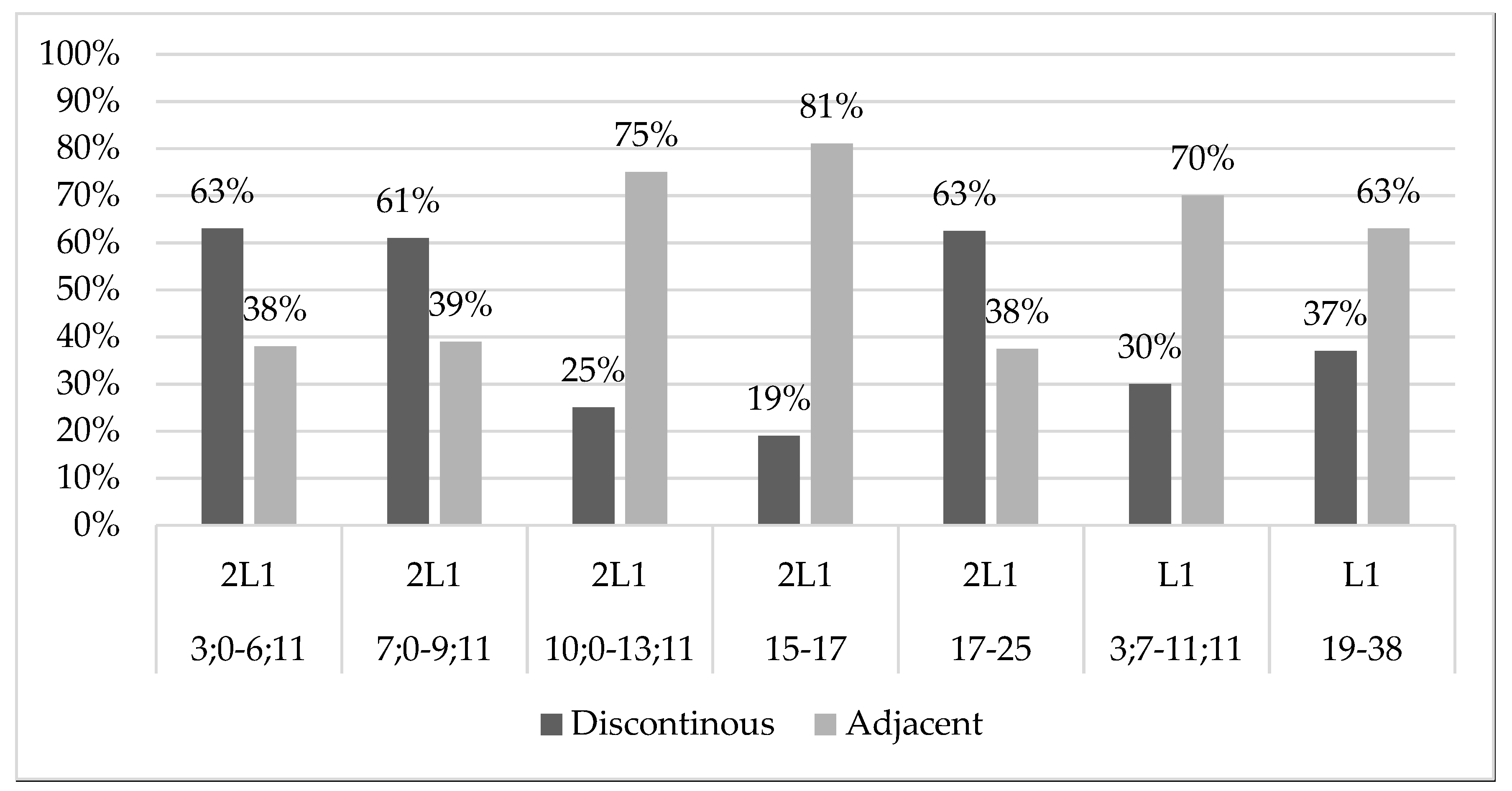
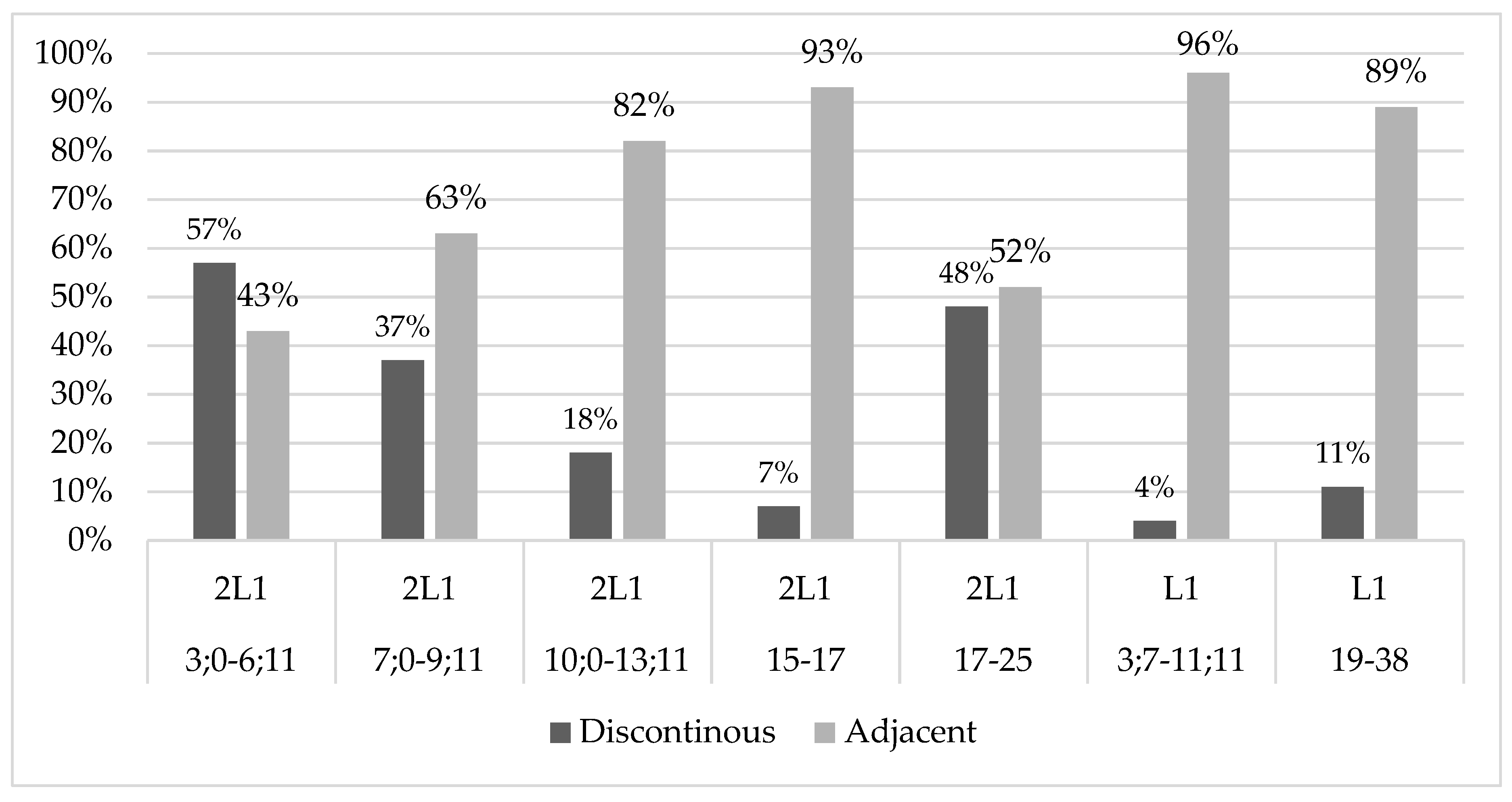
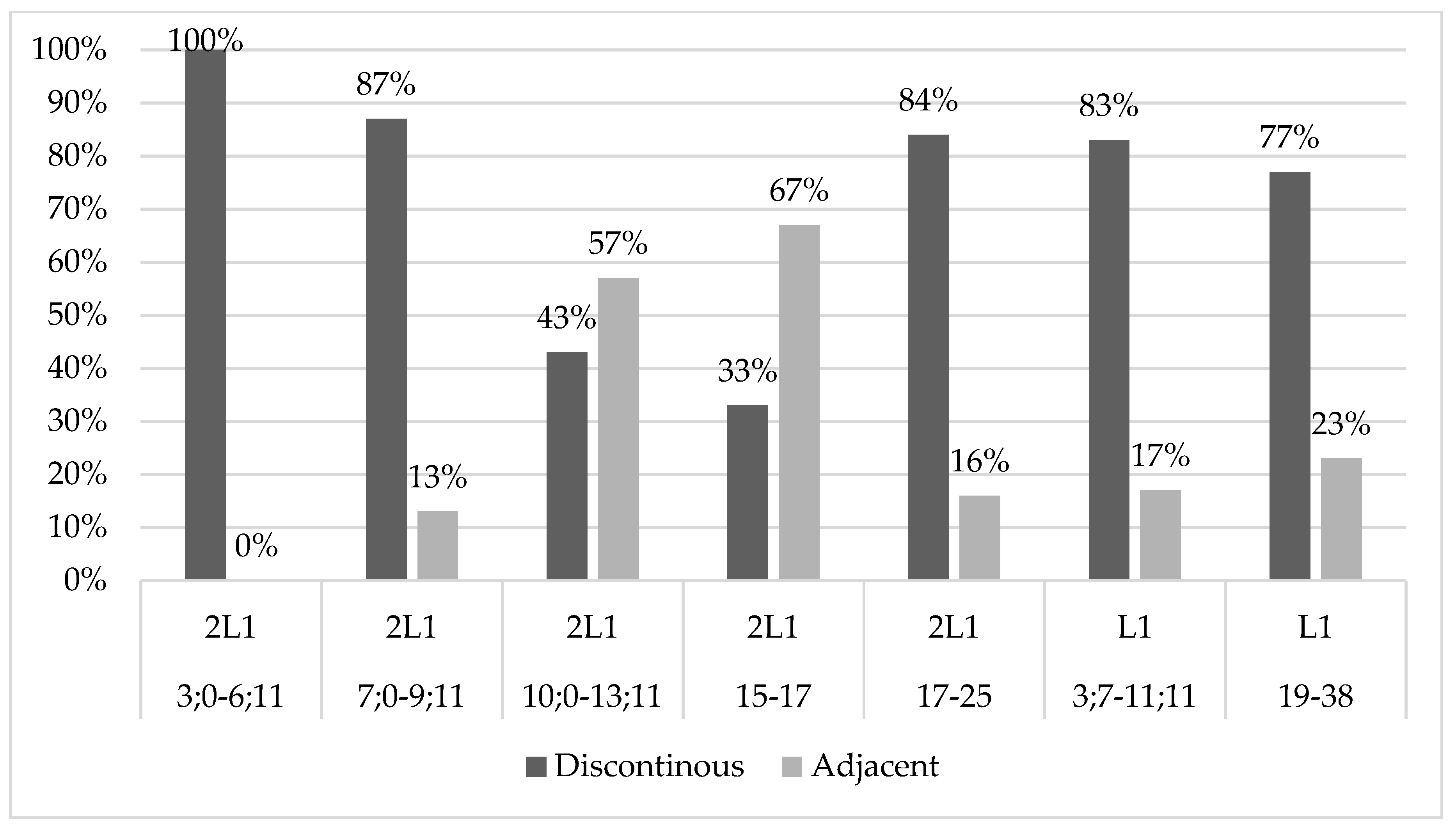
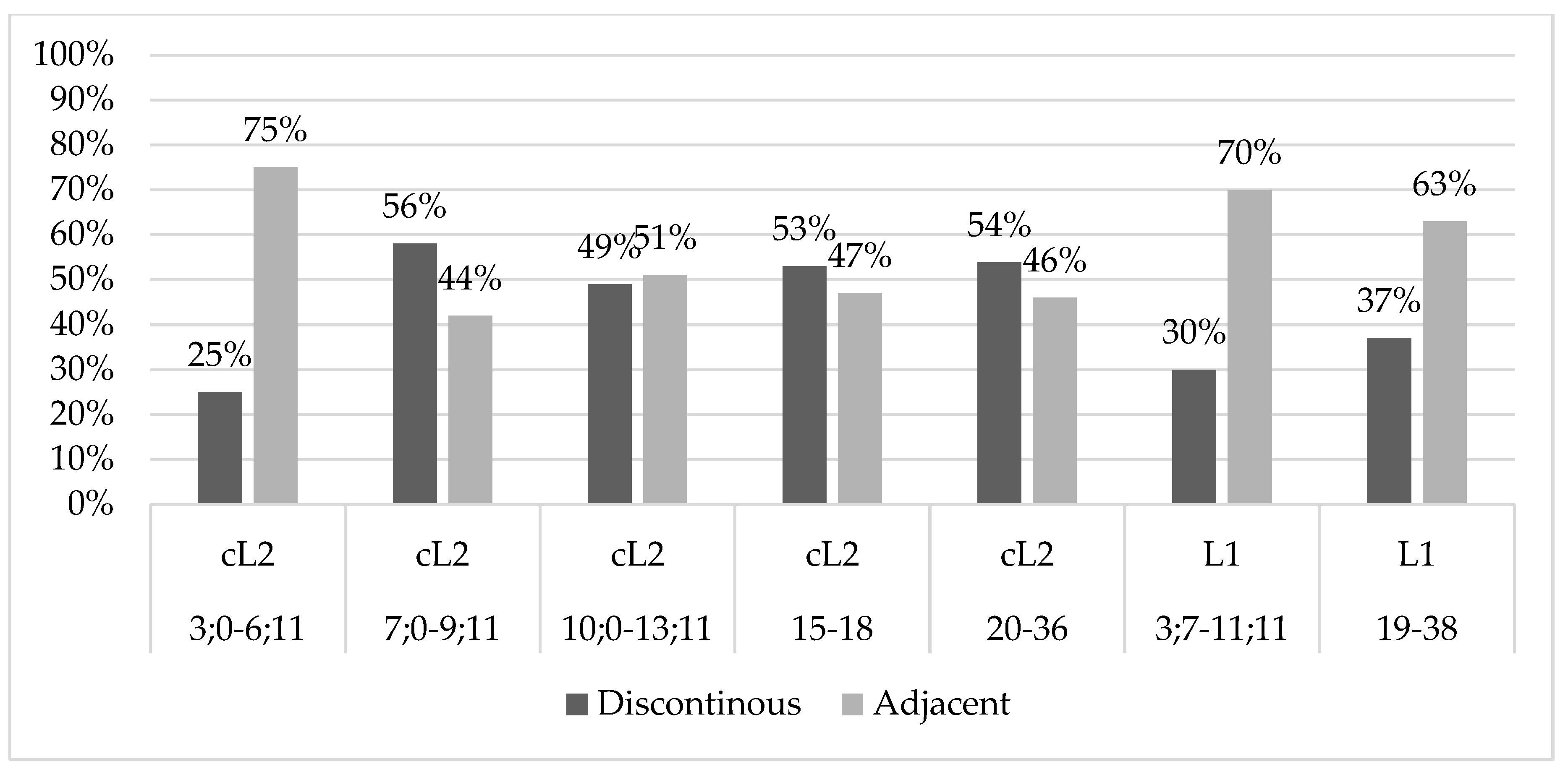

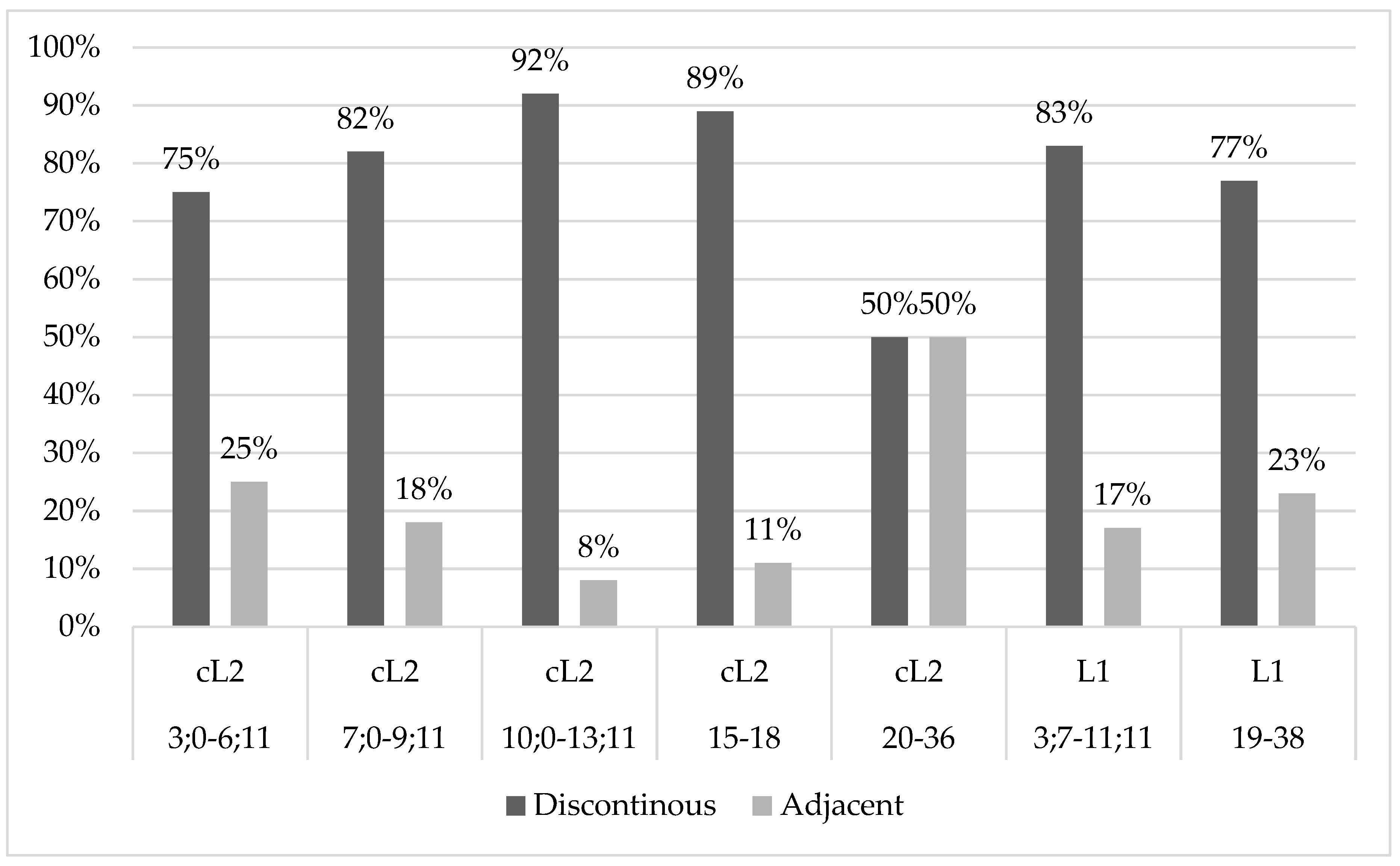
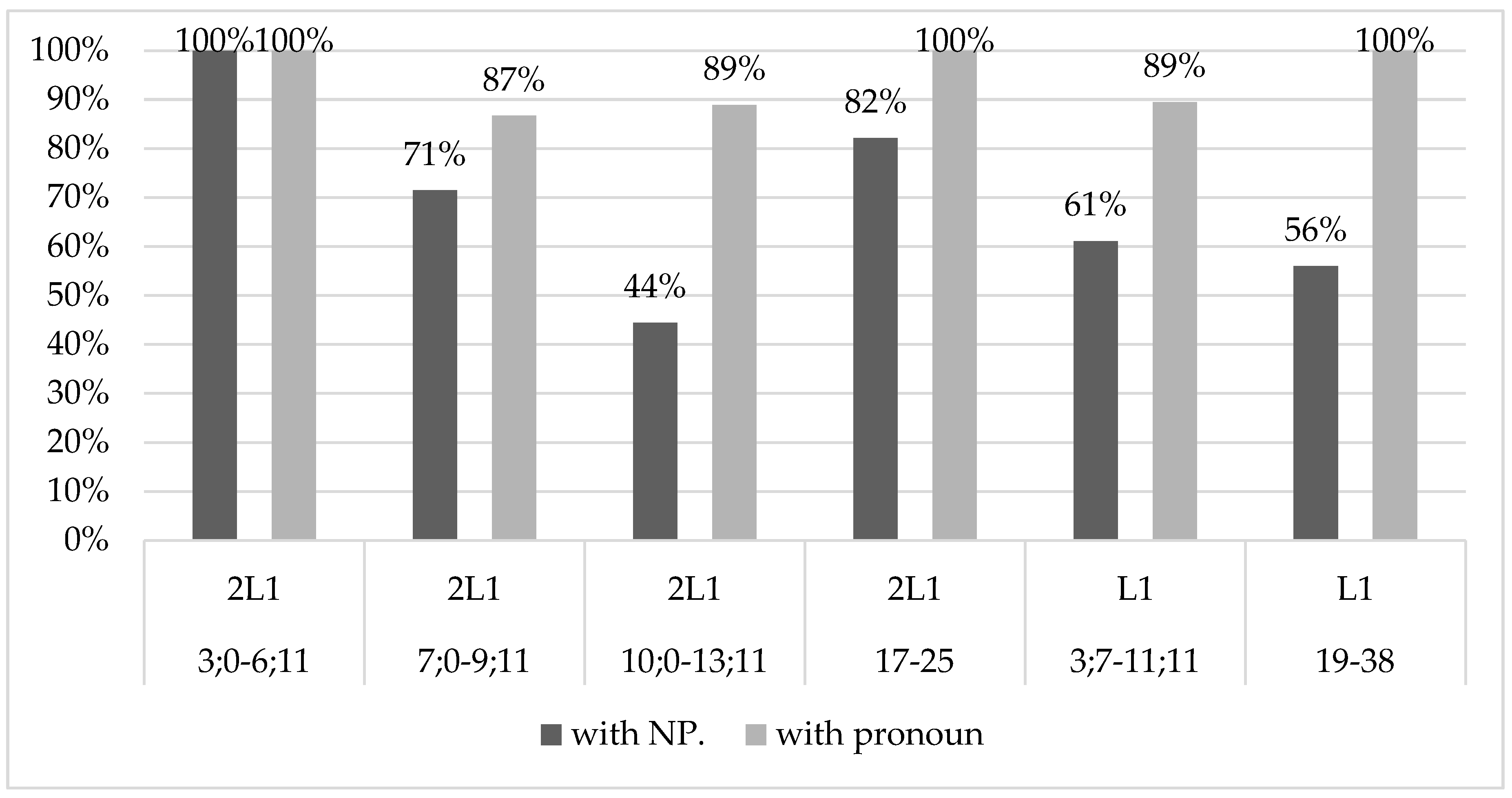
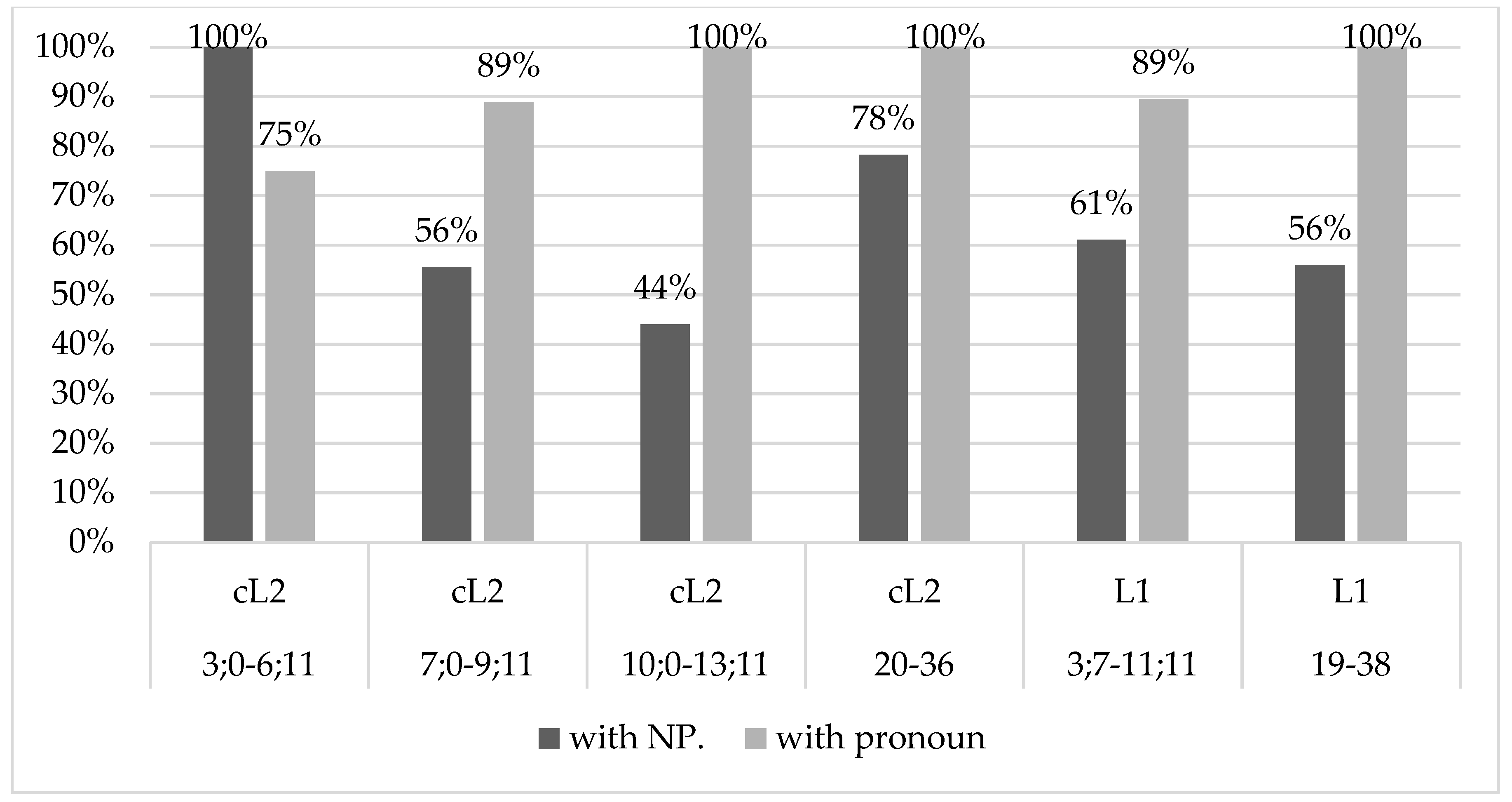
| Age Group | N | Age Span (years; months) | (Mean) | AoO German (years; months) | (Mean) |
|---|---|---|---|---|---|
| AG 1 | 10 | 4;11–6;7 | 5;9 | 0–2;11 | 0;11 |
| AG 2 | 15 | 7;2–9;11 | 8;2 | 0–2;9 | 1;1 |
| AG 3 | 9 | 10;2–13;11 | 12;3 | 0–2;11 | 1;1 |
| AG 4 | 8 | 15–17 | 16 | 0–2;0 | 0;3 |
| AG 5 | 19 | 17–25 | 20 | 0–2;0 | 0;4 |
| Total | 61 |
| Age Group | N | Age Span (years; months) | (Mean) | AoO German (years; months) | (Mean) |
|---|---|---|---|---|---|
| AG 1 | 4 | 5;0–6;11 | 6;1 | 3;1–4;7 | 3;9 |
| AG 2 | 9 | 7;10–9;10 | 8;7 | 3;2–6;10 | 5;4 |
| AG 3 | 10 | 10;4–13;5 | 11;1 | 3;0–7;2 | 4;9 |
| AG 4 | 7 | 15–17 | 16 | 3;0–6;0 | 4;2 |
| AG 5 | 11 | 21–36 | 27 | 3;0–7;0 | 5;0 |
| Total | 41 |
| Age Group | N | Age Span (years; months) | (Mean) |
|---|---|---|---|
| Children | 20 | 3;7–11;11 | 7;10 |
| Adults | 30 | 19–38 | 24 |
| Total | 50 |
| Age Group | Simultaneous Bilinguals | Early Sequential Bilinguals | Monolinguals |
|---|---|---|---|
| AG 1 | 32 | 12 | 80 |
| AG 2 | 51 | 36 | |
| AG 3 | 48 | 62 | |
| AG 4 | 21 | 34 | |
| AG 5 | 104 | 39 | 155 |
| Total | 256 | 183 | 235 |
Publisher’s Note: MDPI stays neutral with regard to jurisdictional claims in published maps and institutional affiliations. |
© 2021 by the authors. Licensee MDPI, Basel, Switzerland. This article is an open access article distributed under the terms and conditions of the Creative Commons Attribution (CC BY) license (https://creativecommons.org/licenses/by/4.0/).
Share and Cite
Brehmer, B.; Sopata, A. Word Order in Complex Verb Phrases in Heritage Polish Spoken in Germany. Languages 2021, 6, 70. https://doi.org/10.3390/languages6020070
Brehmer B, Sopata A. Word Order in Complex Verb Phrases in Heritage Polish Spoken in Germany. Languages. 2021; 6(2):70. https://doi.org/10.3390/languages6020070
Chicago/Turabian StyleBrehmer, Bernhard, and Aldona Sopata. 2021. "Word Order in Complex Verb Phrases in Heritage Polish Spoken in Germany" Languages 6, no. 2: 70. https://doi.org/10.3390/languages6020070
APA StyleBrehmer, B., & Sopata, A. (2021). Word Order in Complex Verb Phrases in Heritage Polish Spoken in Germany. Languages, 6(2), 70. https://doi.org/10.3390/languages6020070







